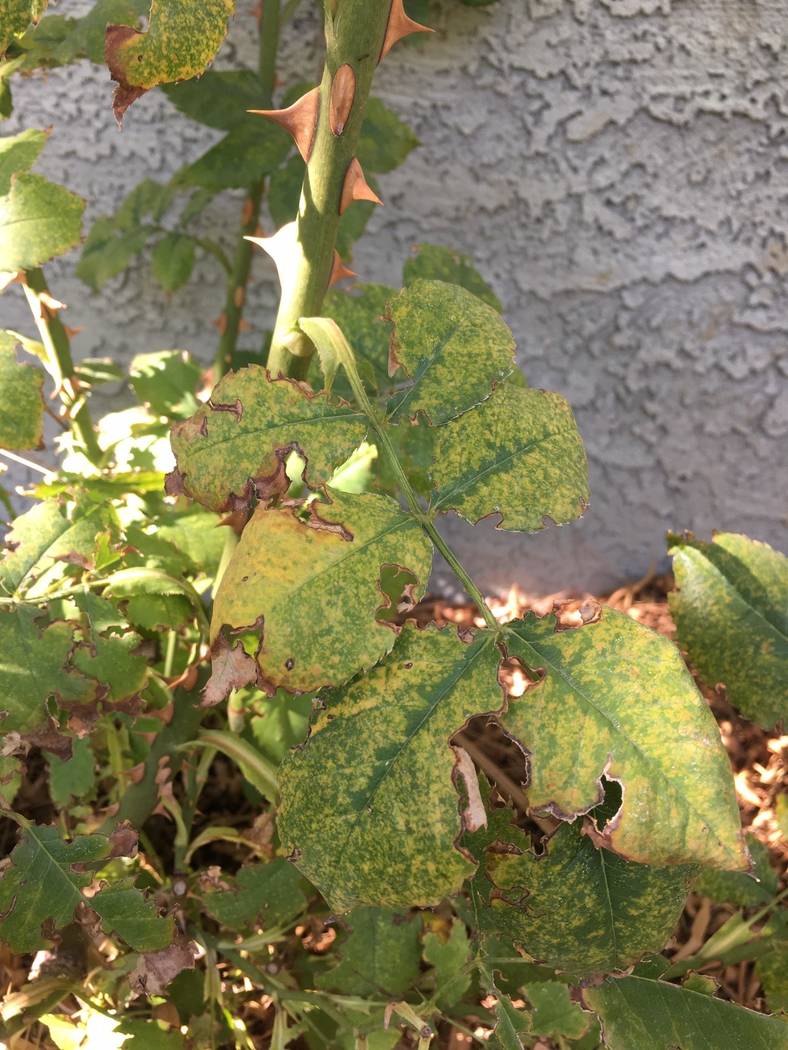Using rock as surface cover contributes to soil problem
Q: I cut back my roses last midwinter and they grew back just fine this summer. Later, all the leaves became discolored, blotchy yellow. Do you have any advice on how to correct this and prevent it from happening next year?
A: When it’s hot, the roses use more water. When temperatures cool off, they need less water. If the soil stays soggy when temperatures begin cooling, the newest leaves begin to yellow. It’s an iron problem called chlorosis caused by suffocation of the roots.
Rock placed on top of the soil contributes to a soil problem, but wood chips won’t. Spraying the plants with iron fertilizer might be a temporary fix but not a long term one.
Roses like soils that allow water to drain from around the roots. To get this kind of soil there must be organics in the soil. Organics come from things that rot, not rock. Putting rock on top of the soil causes the soil to lose its organic content over time. But the slow digestion or rotting of organics such as wood chips keeps the level of organics in the soil high over time.
The rotting of organics is caused by moist soil, plant nutrients in the soil like nitrogen and warm soil temperatures. Rich compost has lots of plant nutrients like nitrogen and organics all bundled together. The bundle of organics and nutrients all rotting together helps keep a healthy balance of good chemistry that benefits the plant nutritionally and environmentally.
To correct the yellowing problem requires some expense and work on your part. When temperatures start to cool off this fall, remove whatever is covering the surface of the soil. Mix iron chelate called EDDHA with some rich compost at a rate of about 2 ounces per cubic foot of compost.
Auger holes around the roses to about 12 inches deep and pour the compost and iron mix in the holes and irrigate the plants. Replace the surface cover with wood chips to a depth of 2 to 3 inches. Spray the leaves with a liquid iron fertilizer three times, three to four days apart.
In the early spring, each year mix one ounce of EDDHA iron chelate in a bucket of water and pour it around your roses with your favorite rose fertilizer. That should prevent leaf yellowing of roses.
Q: I really didn’t understand the soil here, did not dig large enough holes and didn’t amend the dirt when I planted my oleanders. It’s been five years, and I’ve tried to correct their scrawny growth by adding plenty of mulch and fertilizing regularly, but the growth continues to be weak. Do you have any suggestions on how to encourage stronger growth?
A: As a friend of mine would say, “Pay me now or pay me later.” At some point, you will pay the price for good plant growth and modify the soil at planting time or later when it is more difficult.
Whether it is raw desert soil or imported soil brought into the development by the developer, soils are typically horrible in the Las Vegas Valley. Constructing planting holes at the very beginning and using amendments are extremely important for good plant growth. It’s cheap insurance.
Oleanders are Mediterranean plants. They grow well in a Mediterranean climate and soils but need some help when grown in the desert. The help is in the form of constructing a decent planting hole, using soil amendments that encourage good growth when the plant is young and adding supplemental water. They love the heat and low humidity of our desert environment.
Now you have the job of amending the soil after it has been planted. Hopefully, your oleanders were planted with at least six hours of full sun every day. If not, prune any interfering trees so that they receive enough sunlight.
Auger holes 12 inches deep around these plants so the holes occupy about half of the surface area. Fill these holes with a rich compost or make a rich compost by mixing a granular fertilizer like 16-16-16 with standard compost at the rate of two grande coffee cups full for each cubic foot of compost.
Construct a donut around the plant for containing the irrigation water and hand irrigate for about two weeks filling the donut each time. After that, let your irrigation system take over. Prune it after about three to four years of growth and fertilize lightly each spring.
Q: I have a Chitalpa tree that faces west with lots of direct sunlight. The tree bark has separated from the trunk, leaving the inner portion of the tree exposed. There are very few leaves on the tree.
A: The tree trunk has sun damage probably because the tree’s lower limbs were removed too soon. This sun damage has caused the bark to be easily lifted from the damaged part of the trunk. Sunburn has cooked the living part of the tree that faces west while the side facing east might still be alive.
Sunburn of the trunk can leave it exposed to other problems like wood-boring insects (borers) and diseases like sooty canker. Let’s hope it is just sunburn on the trunk causing poor growth.
My concern is that the tree might be surrounded by rock. Reflected heat from the rock can damage the trunk if the tree was pruned so the lowest branches are removed. Not a good idea when the tree is young and the trunk susceptible to sun damage.
When trees are young, leave the lowest branches attached to the trunk to help shade it from sun damage, particularly from the west side. Remove lower branches when the trunk gets older and develops a thicker bark layer that insulate it from direct sunlight.
If there are no insect and disease problems, the tree will heal itself by rolling over its new growth on top of the damaged area. The tree just needs adequate water and fertilizer to do this.Apply water to a large area under the canopy. This area should be at least half the area under the canopy. Apply enough gallonage so the applied water wets the soil to 18 inches deep. Although this tree can handle a rock landscape, water it as frequently as fruit trees and other nondesert landscape trees.
Q: I’m digging out an area to plant a Chilean mesquite, and the dirt is terrible. I’m going to dig a hole about 6 feet in diameter, nice and wide, and to the depth of the rootball like you said. I want to replace all the dirt in the hole with quality soil.
A: Chilean mesquite could be considered a desert or desert-adapted tree. This means that irrigation water can be used to control its growth and size. This tree should be irrigated with the same frequency of irrigation water as other desert landscape plants. You can put it on the same irrigation valve as other desert plants. It can be grown with fewer organics in the soil than nondesert plants and the soil can be covered in rock.
When shopping for replacement trees, the best tree selection is one that is compatible with your existing landscape. If your existing landscape is dominated by nondesert plants and irrigated that way, then a nondesert tree might be the best choice for your landscape unless you are able to water it differently from other plants in the vicinity.
You have selected Chilean mesquite, a desert tree. Though desert trees can be planted in soils not amended as much as nondesert trees, I would thoroughly amend the soil at planting time to get the tree off to a good start.
Add an equal volume of compost to the soil taken from the planting hole and mix it. Use this soil as backfill around the tree and collapse the edge of the planting hole while adding the amended soil at the same time. Make sure the soil is wetted thoroughly as the tree is planted to remove air pockets. Do this three or four times before putting it on an irrigation system.
Rock would be acceptable for a surface soil mulch instead of wood chips, and make sure the tree is staked to keep the roots from moving during strong winds.
Bob Morris is a horticulture expert and professor emeritus of the University of Nevada, Las Vegas. Visit his blog at xtremehorticulture.blogspot.com. Send questions to Extremehort@aol.com.






























